Fighting the tide
The rocketing demand on the NHS from homeless patients and the staff trying to break the cycle
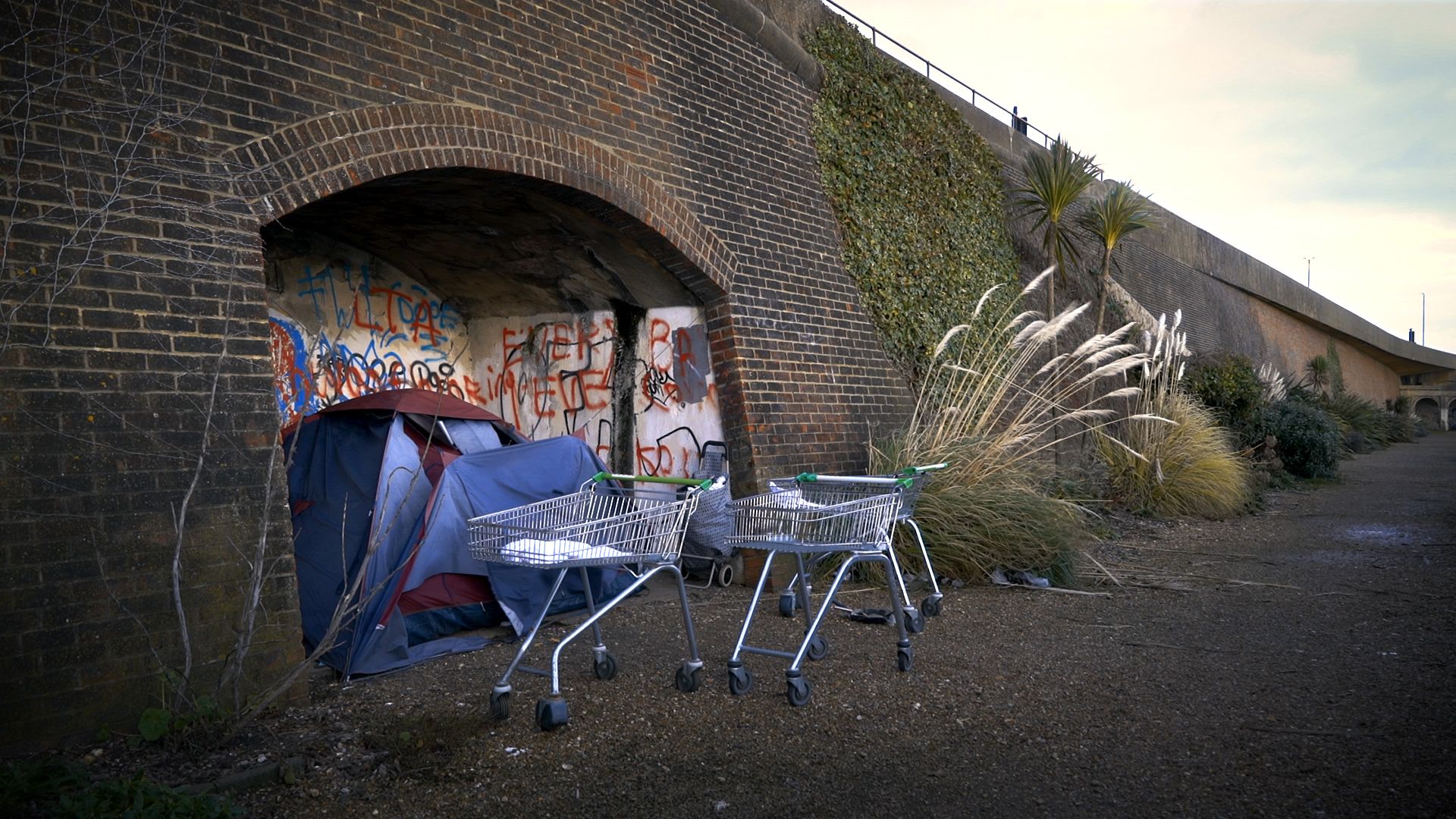
Homeless people are attending hospital in ever greater numbers, often stuck on wards for weeks before being discharged back to the streets where they face a spiral of decline, readmission and premature death.
An investigation by the BMA reveals the scale of the crisis and we meet the doctors in Brighton and London working to restore hope.
Brighton

Outside the window of the cramped single bedroom, autumnal seaside winds howl, picking the peeling paint away from the exterior of a once-grand Georgian town house.
There is no grandeur inside. A tiny yellowed fridge buzzes, door hanging open; a single hotplate sits next to a muffled radio and tumbles of stained clothes.
A man stares at the ceiling – lying fully dressed, unmoving, on a crumpled mattress; his feet wrapped in an uncovered duvet. Sometimes he responds to questions from his visitors, managing a barely audible ‘yes’ or ‘no’. Sometimes he is unable to muster a response.
Plans for a future GP appointment and another visit are discussed. The likelihood of any movement is unclear, but the visitors continue to try.
Just months ago, this man had the sort of life most people would call normal. He had a job and a wife. But now, emergency accommodation in Brighton – gloomy corridors hiding barely habitable rooms – and visits from GPs, nurses and charity workers are his daily existence.
In Brighton, just like much of austerity Britain, even those living ‘normal’ lives can be just one misfortune away – the death of a loved one or the loss of a job – from becoming another statistic in the hurtling growth of the homeless community.
On the pebbles of the beach, a tiny sky-blue tent, guy ropes clinging to a fence, flutters in the wind. The tent remained, steadfast, during two of our visits, nearly two months apart.
Behind it, in vibrant, multi-coloured font: ‘Visit Brighton.’
Tents worth as little as £20 or £30, as permanent accommodation for human beings, are common here – as in many parts of the country – as the number of people falling into homelessness, and struggling to find their feet again, grows.

We visited Brighton to shadow the work of GP Chris Sargeant and clinical services manager for the local homeless team Caterina Speight. The duo, pictured below, visited as many patients who were treated in hospital and then found accommodation, of one kind or another, as possible.
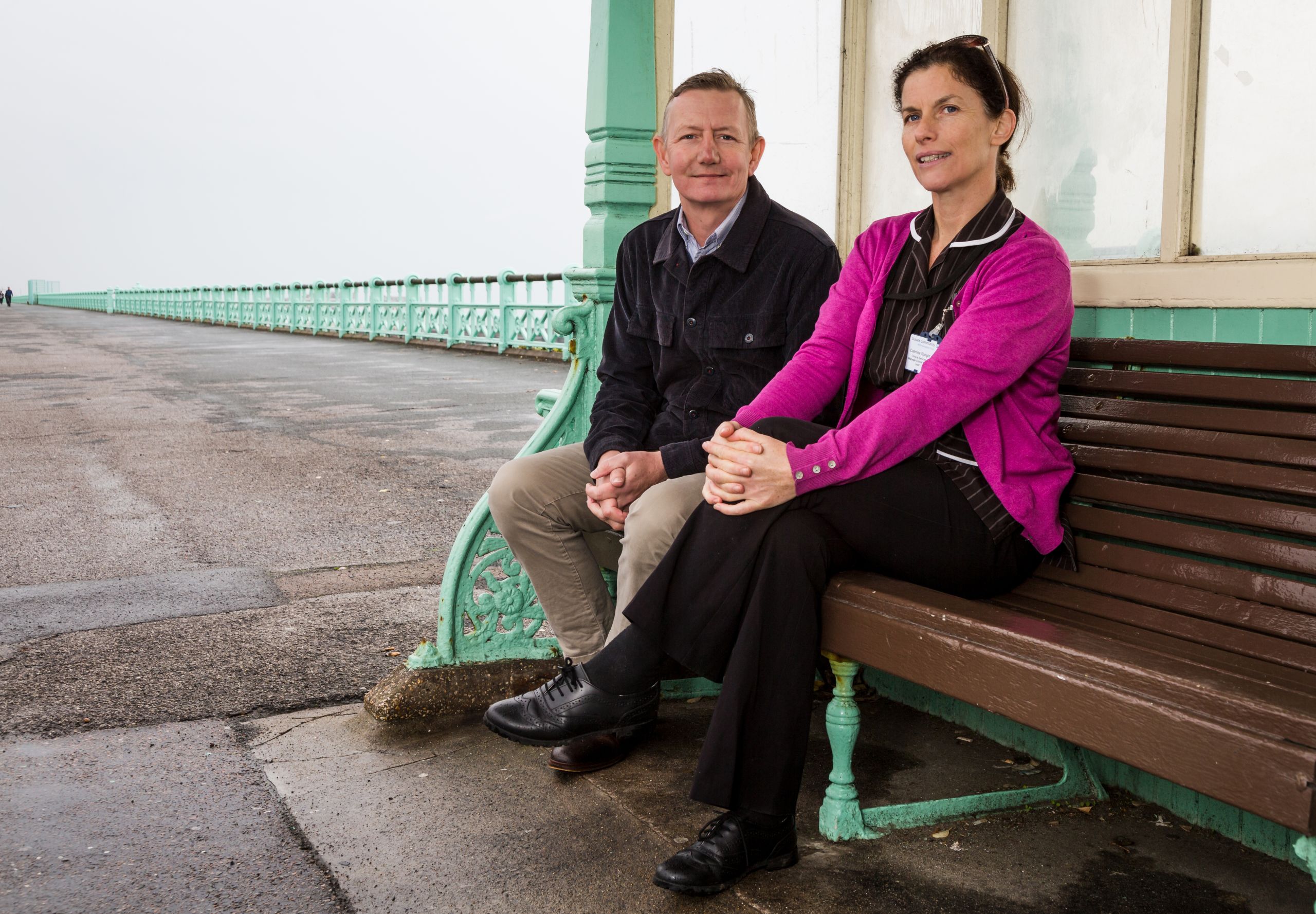
There are around 10 emergency accommodation sites in Brighton. The staff were well-meaning and pleasant but the properties were shabby and dark; hardly suitable for the average person, let alone the most vulnerable and unwell patients outside hospital.
‘It’s not ideal, at all,’ Ms Speight says, ‘but it is better than nothing.’
On the way from one location to the next Dr Sargeant and Ms Speight receive calls about patients on their list and try to tie their care together as much as possible. Considering the amount spent in acute care each day it is amazing to see two frontline staff trying to do so much, for so many, while working from a Nissan Micra; patients have been raped, have infected wounds, chronic substance misuse and are in sex work.
Complex does not even begin to cover it.
Between them they forge hard-fought-for relationships – these patients can ‘take a long time to give you their trust’, Ms Speight says – to encourage patients to go to hospital, make GP appointments and engage with other services. In many cases engaging with other services is far easier said than done – and is becoming increasingly difficult as austerity continues to bite.
‘They are chronically underfunded – they are just not there to access,’ Ms Speight says, when asked how austerity politics has affected the ability of health professionals to access support services such as substance misuse services, social care and, particularly, mental health services.
‘We can identify immediate need but the delay in getting help to people and services around them is just huge. It comes down to people like us to try and cope with patients who need this kind of specialist help – it’s work we shouldn’t be doing and it has an impact.’
London

The closest Lee Snowball came to home comforts for 17 years was a makeshift bed in a lift shaft, bottles of milk pinched from estate doorways, and a stolen sofa in an abandoned garage. Life was ‘tough and lonely’ – sometimes he had to fight, literally, to survive.
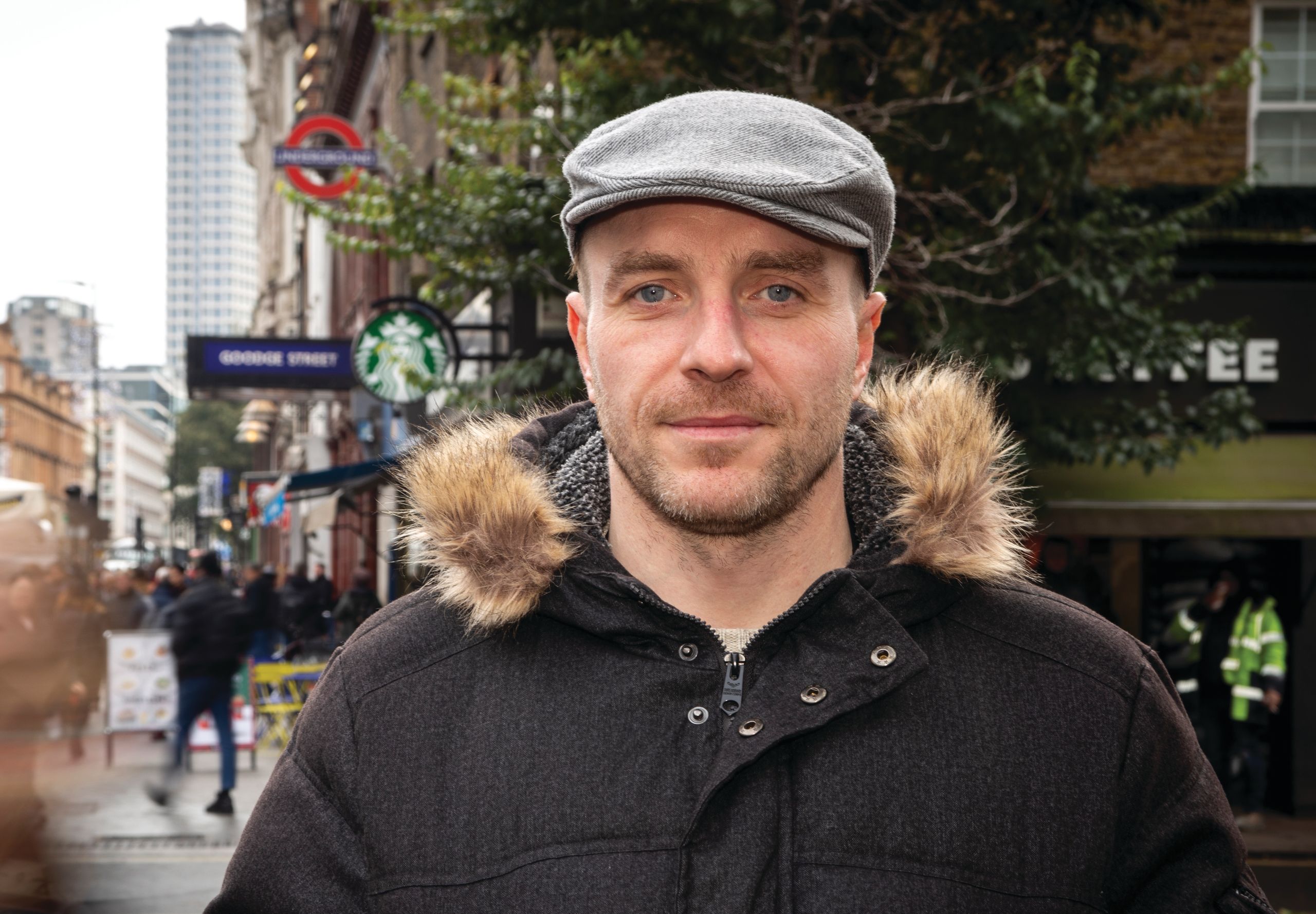
In 2016, those thousands of nights sleeping rough, or staying with friends, had taken their toll on his body and significant surgery was required to correct a bowed knee and some other, resulting, issues.
After successful surgery Mr Snowball faced a return to sleeping in the park near his godmother’s house or taking shelter in the cubbyholes and rabbit warrens of a North London housing estate – on crutches, with a large, healing wound.
However, medically fit for discharge is surely not equivalent to fit for discharge to the streets?
As a Department of Health study published in 2010 said:
‘Clearly, living conditions on the streets are not conducive to recovery from poor health; neither do hostels provide all elements of a good environment for recovery.’
Readmission and complications would have been almost inevitable in Mr Snowball’s case. He faced becoming a victim of a vicious cycle, a spiralling relationship between ill health and homelessness.
His is just one story behind a growing avalanche of statistics, with the interaction between homeless patients and the NHS rocketing as the cuts to services and stored up trauma of austerity policies bite across the country.
With the cheapest hospital admission averaging £1,603, according to NHS Improvement, this year’s bill sits at £18.7m, at the very least.
The homelessness crisis is a situation the BMA declared a public health emergency at its annual representative meeting in 2019. Doctors called for the rollout of integrated inpatient homeless healthcare and wide-ranging action across the health system.
BMA emergency medicine lead Simon Walsh has said rising homelessness is ‘soul-destroying’ and the needs of homeless people continue to be ignored.
On a national level, Dr Walsh is right. But in London and Brighton, and in a handful of other cities, there is a blueprint which attempts to fill the gaps and wrap care around homeless patients.
A life line
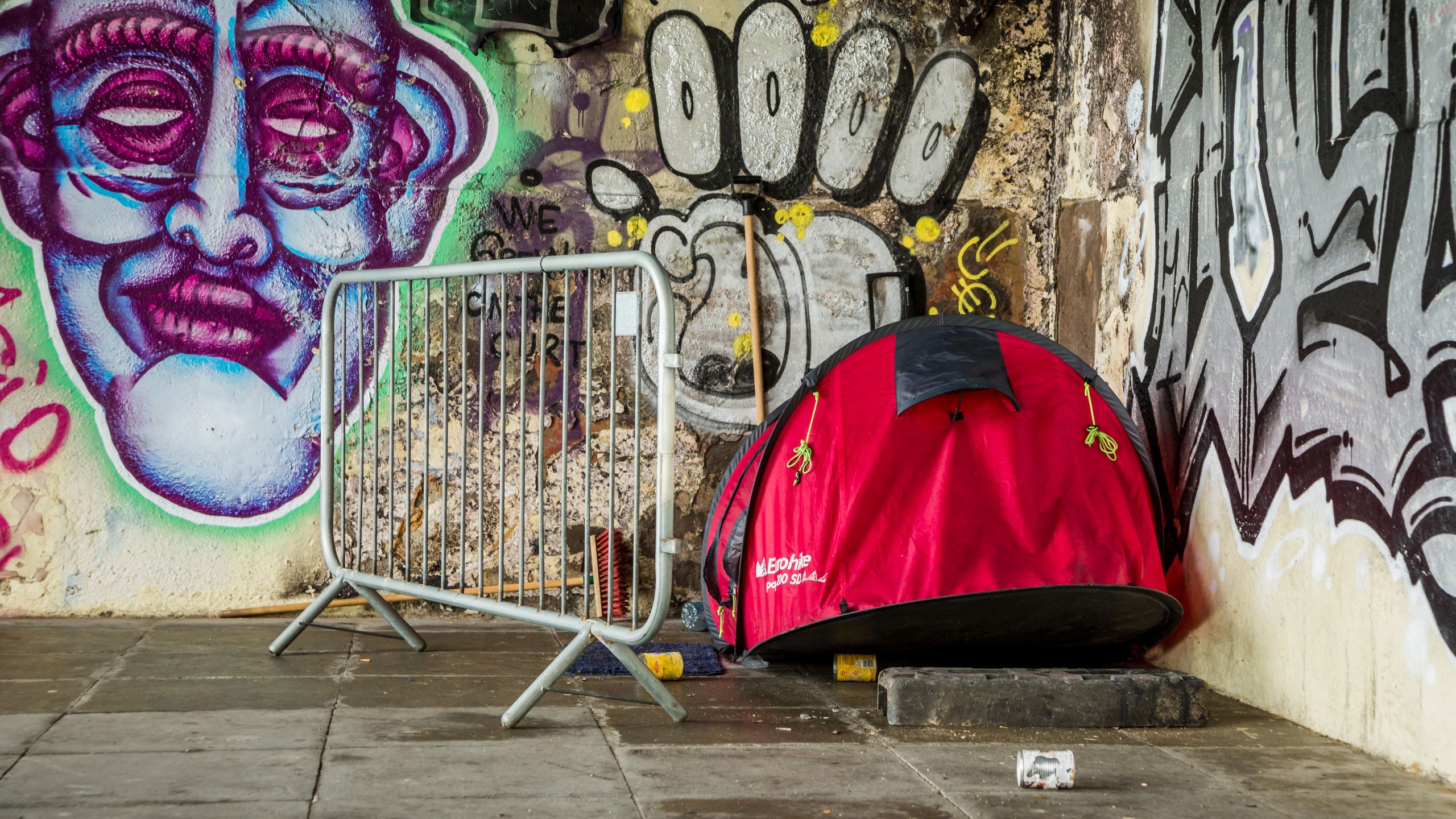
When Mr Snowball was admitted in 2016 a member of the Pathway team at University College London Hospitals became aware of his case.
The teams are generally based on a GP-led model where a small team of health professionals is integrated into a hospital trust. The team identifies the complex issues in a homeless patient’s life on admission and uses their expertise to address the problems while they are in a place where they can be helped.
It is a simple idea that allows hospital trusts to do more than just discharge homeless patients to the streets, and count the days until their next admissions.
In Mr Snowball’s case the Pathway team allowed him to access a solicitor, found temporary hostel accommodation, helped to address his health and addiction issues and eventually assisted with finding a flat. Mr Snowball’s daughter has moved in with him and he’s able to volunteer with local projects.
‘I wouldn’t have anything that I have now, without having been to hospital, without them helping me,’ Mr Snowball reflects. ‘Things have all fallen into place quite nicely. They’ve started my life rolling again and have helped me all along the way. It has just gone onwards and upwards.’
Progress in Brighton
The Pathway model in Brighton comprises the homeless GP practice Arch on Morley Street and a team based in the local hospital. The team has urged commissioners to fund a step-down facility, where people who are fit to leave hospital but still need support or time to put plans in place, can go – but money has not been found.
Nestled between floors three and four of the Royal Sussex County Hospital, the small Brighton Pathway team, comprising Dr Sargeant, in-reach nurse Gregg Lock and advocacy and discharge coordinator Katie Carter, are on hand every time a patient who is homeless or vulnerably housed is identified. They are ready to meet patients, find out about their history and try to give them any support they need.
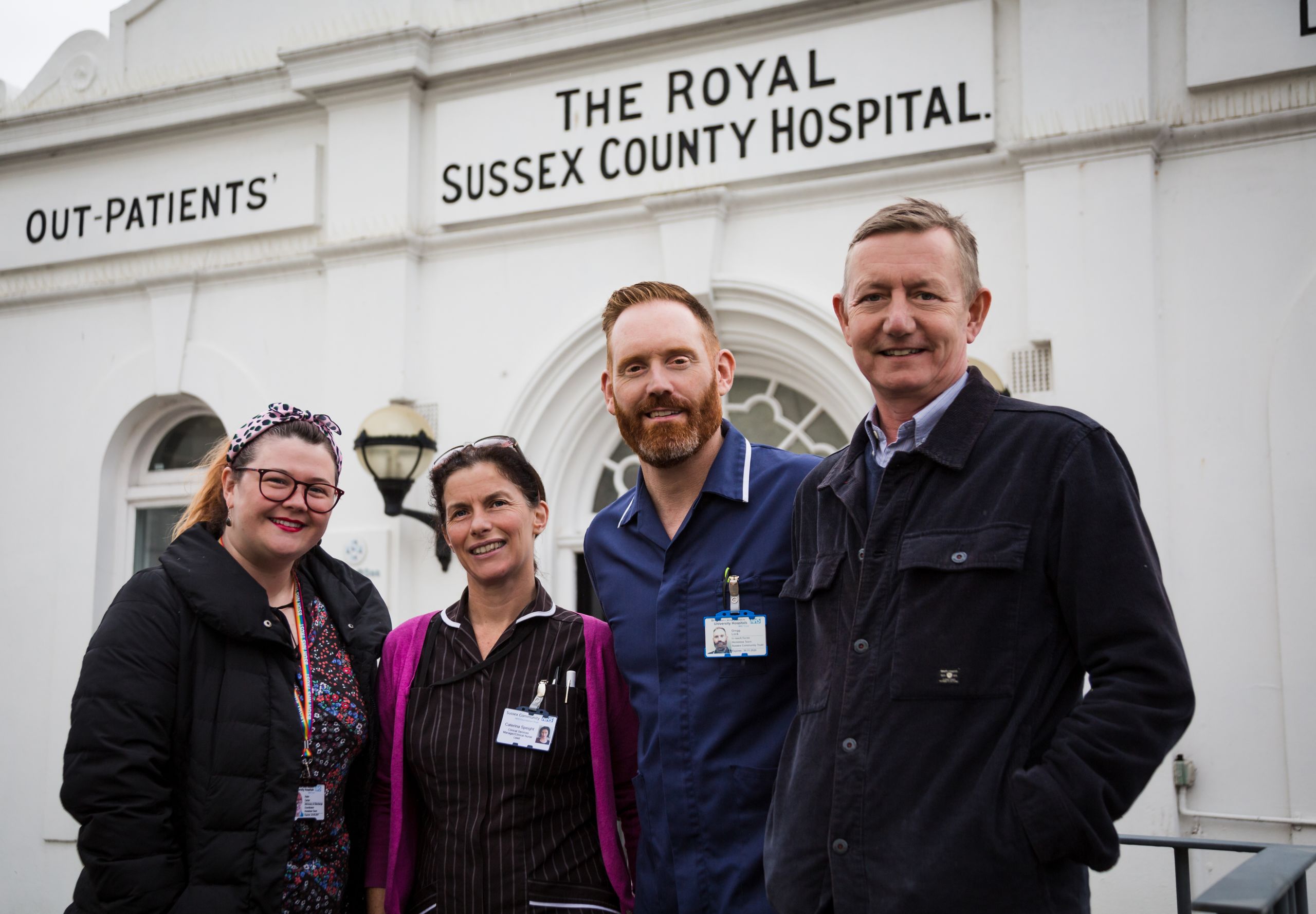
The Brighton Pathway team. From left to right: Katie Carter, Caterina Speight, Gregg Lock and Chris Sargeant
The Brighton Pathway team. From left to right: Katie Carter, Caterina Speight, Gregg Lock and Chris Sargeant
On the day we visit, patients are worried the weather is turning more wintry – and staff are struggling under the pressure of rising demand, with more patients needing help but fewer beds in which to treat them.
Rushing the process is counter-productive; discharging patients to the streets is short-sighted as they will end up back in hospital with further complications. Many would suggest it to be unethical, too.
‘Most people don’t come into the NHS to put people out on the streets,’ Dr Sargeant says.
But if the system is under extreme strain that can have an impact. And there is an understanding that elderly people have to wait on a ward for a nursing bed or care package – but that isn’t the same for homeless patients even though they have many of the same, or worse, frailties.’
The system in Brighton, originally described as Pathway Plus, is now commissioned by the local clinical commissioning group. Once people leave the hospital they are fortunate enough to be visited by a floating team of non-clinical support workers, as well as being registered with Arch or another local GP. This service, commissioned as part of Pathway Plus, is run by Justlife, a homeless charity.
Simon Gale, operations and hub manager for Justlife says: ‘We are still able to intervene and help people. We take a committed, long-term approach and don’t limit how long we work with people. But no matter how hard you try there are some cases where you can’t help – some people die prematurely.’
‘The frustration is we could double our team and still not really feel we are reaching all the people who need support.’
Looking to the future is a concern too. One life experience that ties many homeless people together is early childhood trauma – and the potential effect of austerity policies in this area is a serious worry.
‘The cuts to things like children’s centres and that sort of youth provision means I worry we will increase the number of people who end up homeless.’
The effectiveness of teams such as Pathway Plus should not be measured by the basic statistics NHS commissioners and managers favour, such as emergency care attendances and financial effects – demand is continually going up and complex cases do not fit into basic metrics. But the project here, now running for seven years, is making a difference.
Many similar projects would not be able to demonstrate such obvious effects as those illustrated below.
Efficiency savings miss the mark
In an NHS where the only thing going down is performance against targets, this seems unrealistic. Only 11 hospital trusts have a Pathway team, which could cost as little as £100,000 to £200,000 a year.
A senior leader in a homelessness charity says: ‘The financial lens has become dominant in our healthcare system. If there really is significant new funding coming after the election … if it’s all only to be invested in things that save money or deliver efficiency savings lots of it will miss the needs in the population.’
A different type of evaluation is required.
And, according to local experts in Brighton, other changes are needed too: more understanding of the value of step-down facilities, investment in housing and longer NHS contracts for teams so they can get on and work without looking over their shoulders.
Dr Sargeant says:
‘We’re not asking for the world, but you would be surprised how hard it is to get what we have got now and to get more. It’s not just getting it, it’s keeping it.’
The only thing as striking as the scale, complexity and tragedy of homelessness in Brighton is the commitment, care and compassion shown to the homeless. So often society forgets these patients, but not if these staff can help it.
At the fortnightly multi-agency meeting hosted by the Arch GP surgery, where all the local organisations trying to tackle this desperate issue trace the journeys of their patients and discuss their needs and next steps, that commitment, care and compassion could not be any more obvious.
It is driven home most powerfully when the solemn faces around the table begin to realise they have done all they can for one patient who has no recourse to public funds and will not be helped by the existing structures of society in this country. Consoling the charity workers and healthcare staff who have spent weeks trying to give the man a second opportunity, Arch GP Tim Worthley says:
‘Thank you for everything you are doing for him. You are not missing anything, you are not failing. All we can do is try.’
Under the iceberg
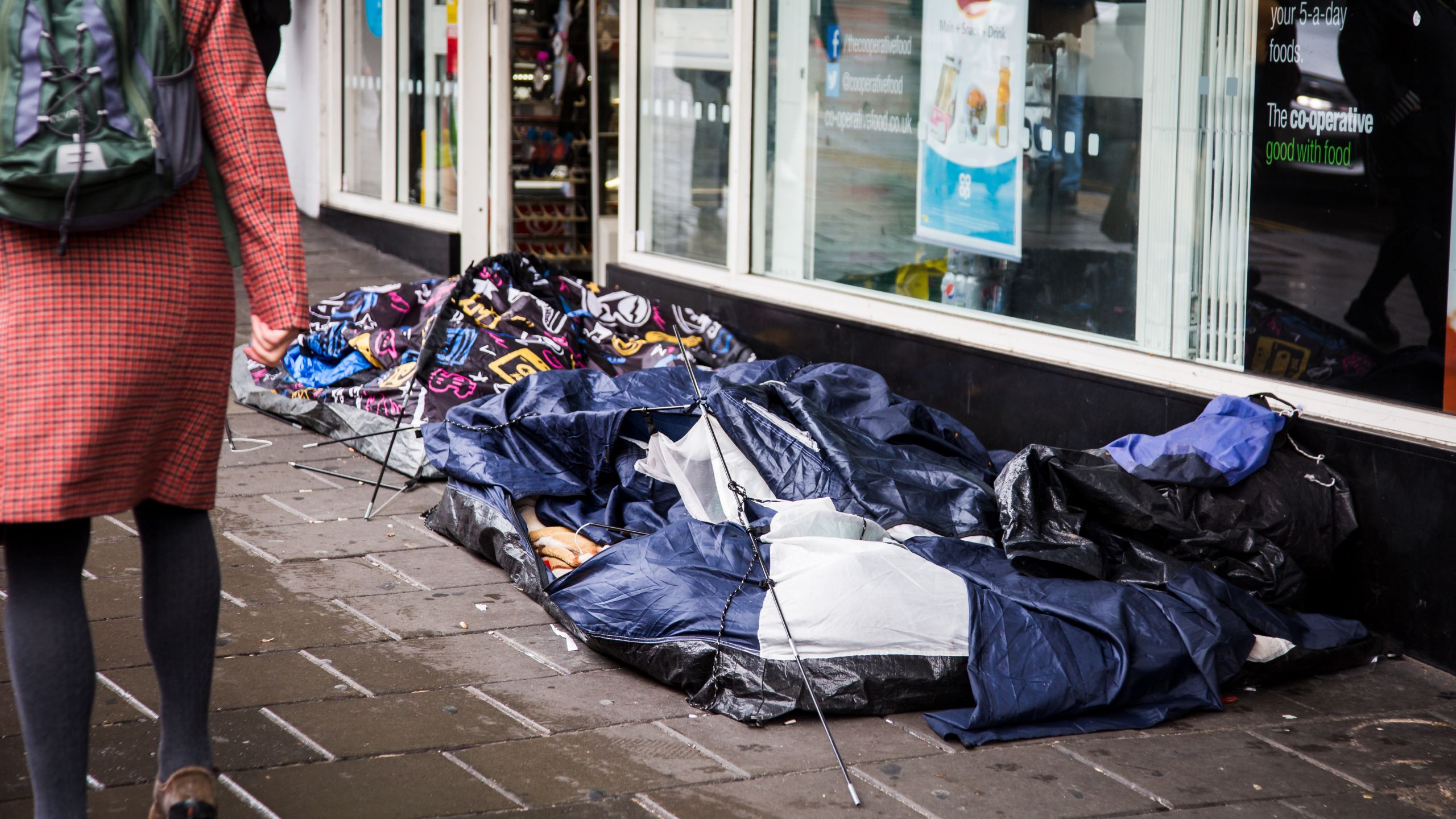
Research illustrates just how complicated hospital discharge for homeless patients can be – and highlights a significant breakdown in the services available for clinicians to access in the community.
Freedom of Information requests by the BMA reveal the number of patients of no fixed abode stuck on hospital wards for ‘long stays’ – defined by the NHS as 21 days or longer.
The reality is likely to be even bleaker than all the statistics gathered for attendances, admissions and long stays – with NHS recording mechanisms notably poor, hidden homelessness a growing issue and a number of trusts not recording data or not responding to requests for information.
Faced with this sort of demand – and without the tools to cope – frontline staff are left in an increasingly difficult position, making decisions that will have a huge effect on the health and life outcomes of their patients.
Homeless patients die, on average, in their 40s.
Barbara Cleaver, emergency medicine consultant at Imperial College Healthcare NHS Trust, says the demand and complexity of patients, combined with lack of ability to make a difference to their homelessness, is obvious on the front line.
‘There is an under-the-iceberg figure of people,’ she says. ‘We have had 20 people sleeping rough in the waiting room and around the hospital grounds – there is a sense that this is a place that is open 24 hours a day and is warm, well-lit and safe.’
‘It’s pretty difficult to feel good about doing your job when you are put in those positions or if you are making people homeless. These sorts of things are happening much more than people think.’
These are patients of great complexity. Research by charity St Mungo’s found that most homeless people demonstrate a tri-morbidity of physical illness, mental health problems and substance misuse. Half its residents have mental health problems, 32 per cent have an alcohol dependency and 63 per cent have a drugs problem.
A report, recently published by the Centre for Health and Development at Staffordshire University, found that homeless patients were often stigmatised or mistreated in healthcare and also, possibly as a result, had difficulties engaging with healthcare.
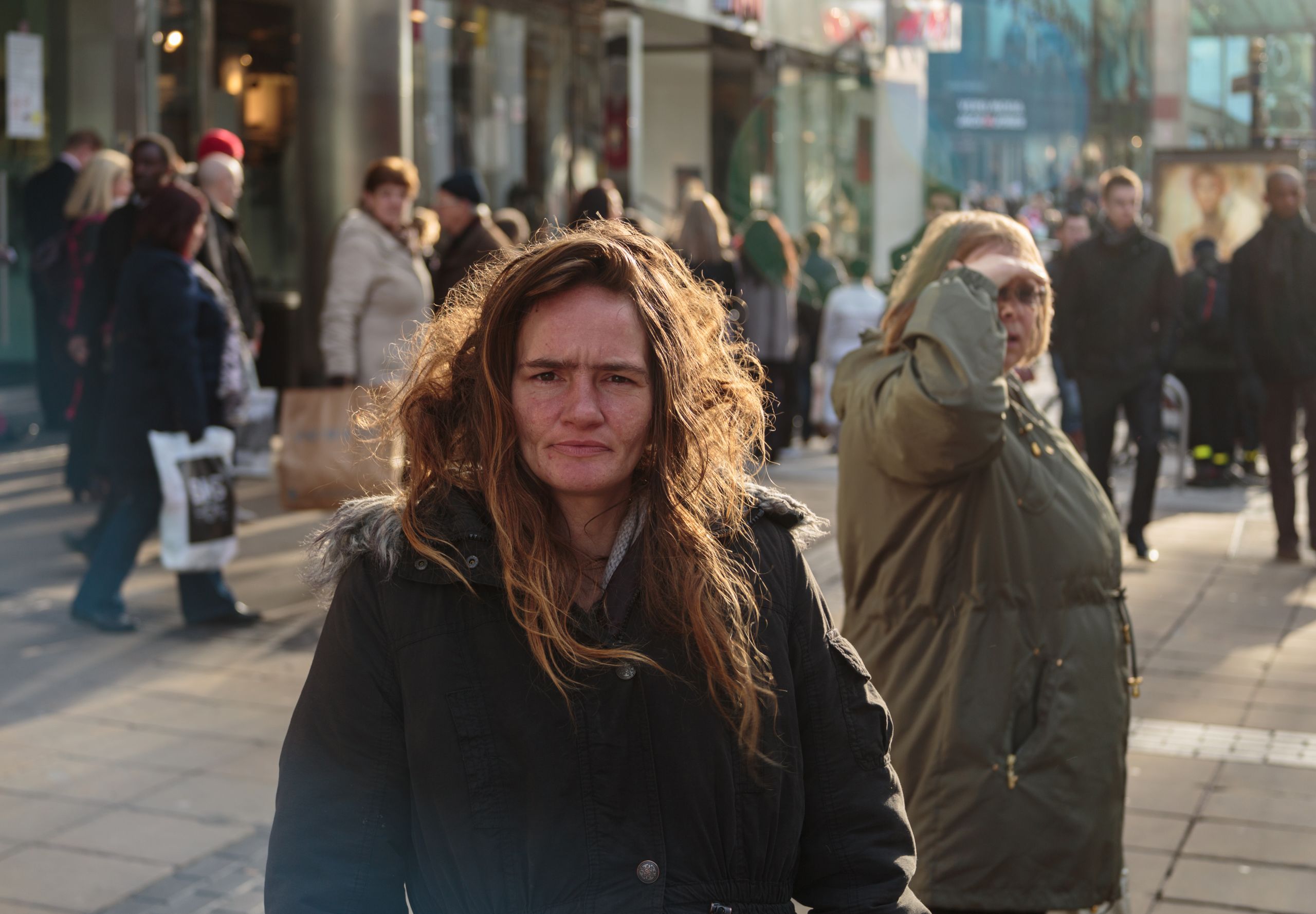
Most striking is that these patients are old and frail 20 or 30 years before their time – and the system is just not equipped to deal with that, or, often, even willing to face up to those extreme vulnerabilities.
‘In any other condition there would be horror that the average age of death in these patients is in their 40s,’ says GP Peter Buchman (featured in the video below), a member of the Pathway team in London.
‘And sometimes in a busy hospital nobody really takes the time to clock some of these issues. They might only be 40 years old, and there is a sense that they should be able to cope, but they are frail young – these patients have the needs of 65- or 70-year-olds, they need support living and have complex needs.
‘The hospital admission is a real opportunity to assess these things and really investigate, but it takes a lot of real pushing and often we need the involvement of us as clinicians to advocate for these patients. It is sometimes about winning hearts and minds.’
The Staffordshire University report says funding cuts have led to a decrease in capacity.
BBC analysis last year found that £162m had been cut from treatment budgets in England since 2013-14, while drug poisoning deaths had risen from 2,734 to 3,450 in 2016.
Cuts have also been seen in mental health provision and social services. Housing is clearly a growing issue, too.
In many parts of the country it is near impossible to gain access to housing. In Manchester the Pathway team reports there being ‘nowhere for patients to go’, and local authority staff have seen fit to remove the ability of clinicians and managers to refer patients directly into services. All patients now must be matched through a centralised system which takes hours to apply to and removes all utility of relationship-building between sectors.
As the Staffordshire University report says:
‘Discharging to hostels and similar temporary accommodation was questioned due to the potential for an unstable environment that again did not meet the needs or expectations of individuals.’
One local authority worker reflects on patients being discharged and given sole responsibility for their care – even ‘released with drains and all sorts of things that need aftercare’.
The alternative is patients stuck in hospital beds, as the long-stay figures show. Neither outcome is successful, or, indeed, ethical.
The integration agenda could also be crucial. Pathway teams are ultimately multi-disciplinary, cross-service teams that bring the best skills together to wrap around the patient’s need.
They display the sort of integration much of the health service only dreams about. And it appears to be effective. But integration talk is cheap – and has been on the lips of NHS leaders for years.
But until all this change is realised, it is in this environment that doctors work and homeless patients live: an environment of ever-growing demand.
Chance to help

The phone seems to ring endlessly in the office of the Pathway team at the Royal London Hospital in Whitechapel. This cramped room may lack the grandeur of hospital boardrooms or the military-style urgency of bed management meetings, but, here, the daily battle of today’s NHS is fully displayed, albeit in microcosm, through the struggles of one cohort of patients.
When that phone rings and signifies the presence of a new homeless patient in hospital, a team of just five staff – a GP, nurse, occupational therapist, social worker and care navigator – spring into action.
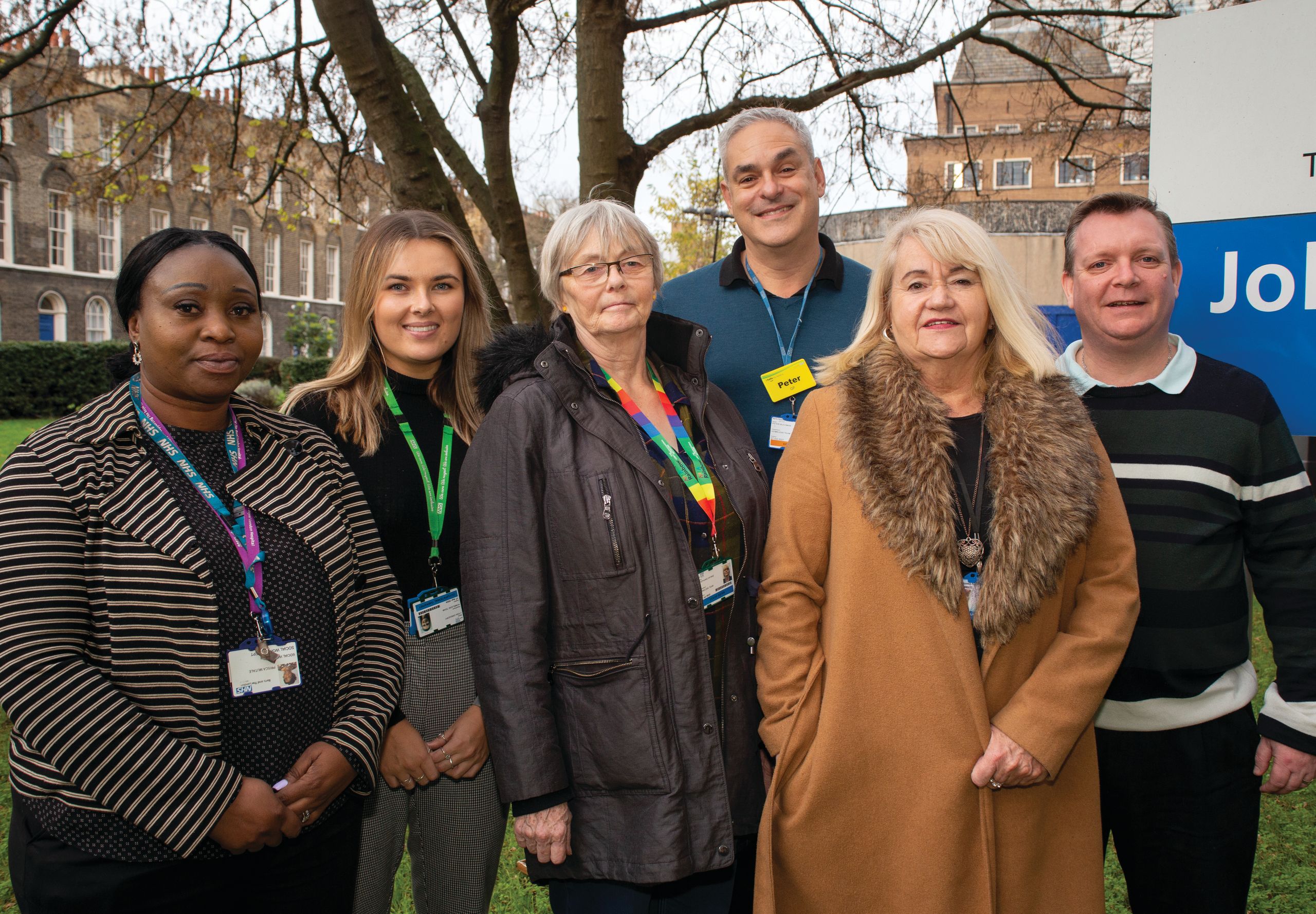
GP Peter Buchman (third from right) and the Pathway team at the Royal London Hospital
GP Peter Buchman (third from right) and the Pathway team at the Royal London Hospital
‘A hospital admission is an amazing opportunity,’ Dr Buchman says. ‘Someone is in a place where you can help them and where they may want help also. It can be an opportunity to break the cycle.’
But across the country a freed-up hospital bed is worth more than its weight in gold. As such, time is of the essence, and constant communication – and more than a hint of persuasion – is often required to find a successful outcome.
Where possible, patients are assessed and their history and issues discussed, GP registration arranged, housing departments called, care packages considered and even shoes, clothing and a mobile phone found.
A plan is put in place.
The team has access to a six-bed step-down facility, which makes a huge difference to the whole process. The Stoke Newington facility comes with access to a large shared kitchen and is manned 24 hours a day.
Dr Buchman says:
‘We’re very lucky to have it – there are a lot of people who there may be a solution for but with all of the frustrations of the system – navigating benefits, lost identification, the housing system and accessing services – sometimes you need a bit more time in a supported environment.’
The effects of Pathway teams and these sorts of facilities can be monumental in a patient’s life – and can have a serious, positive, impact on costs for the health service.
Smiling, Dr Buchman cites the example of a patient treated for a fractured leg, who would have been discharged to the streets. Room was found for him at the step-down facility and it later emerged that he was the unwitting victim of modern slavery.
‘He’s heading for legal status here – he’s somewhere safe and he has the chance to move on to a more normal life. It’s an amazing transformation and just shows the opportunity you have.’
The evidence base for the wider rollout of similar services to Pathway teams is as strong as the evidence of growing need.
A study looking at 410 patients, which included the Royal London, found that the proportion of people sleeping on the streets after hospital discharge was 3.8 per cent in a cohort of patients exposed to a Pathway team, compared with 14.6 per cent receiving standard care.
The BMA understands around 10 more hospital trusts are in discussions with Pathway about introducing teams, but many are citing the need for a demonstration of cost savings as a basic requirement.
Pathway clinical director and GP Nigel Hewett says: ‘We think there are about 50 hospitals that might benefit from the approach. At the current rate [of introducing the system to hospitals] that means we will have to wait another 40 years.’
Steve Wynne, senior Sister in the Royal London homeless team, says: ‘How on earth do people [without a specialist team] manage? They must be sending so many people out on to the streets. The hospitals might think it is a result because they are out of the hospital but they will come back.’
Even in a society increasingly hamstrung by growing demand, the opportunity of a hospital admission remains, according to those who know best. And the case for putting the people in place who can make the most of that opportunity is pragmatic – the NHS needs the respite and, crucially, so do patients.
As Mr Snowball says: ‘It’s about giving people a chance – but it’s also forcing them to take the chance. Putting people around them, giving them the help they need.
‘There are ways to get people off the streets and get their health going again, but you need to give people a push when they need that help.’
Story by Peter Blackburn
This story was originally published in two parts in the December 2019 and January 2020 editions of The Doctor magazine.

